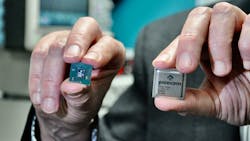First SoC for 5G Small-Cell, Open RAN RUs Makes its Debut
This article is part of the TechXchange: 5G Infrastructure.
The Overview
Picocom’s PC805 is touted as the industry’s first system-on-chip (SoC) optimized for 5G small-cell Open RAN radio units (O-RUs). As a highly integrated, small-footprint, low-power SoC, the PC805 is expected facilitate implementation of 5G NR/LTE small-cell O-RUs in use cases including enterprise, industrial, neutral host, and private networks.
Who Needs It & Why?
Accelerated adoption of Open RAN technology, which is hoped to break the hegemony of large, integrated network-equipment vendors in the buildout of 5G infrastructure, depends in part on the availability of optimized and widely available silicon. SoCs like the PC805 are key to neutral-host and private network deployments as well as greater network density.
A preponderance of existing O-RU products is based on FPGA technology, which makes it necessary to redesign hardware to address different use cases. The PC805 enables these changes to be largely accommodated with simple software changes. The resulting small-cell deployments can fuel more carrier aggregation and flexible usage of spectrum.
Moreover, spectrum aggregation is important to neutral-host network operators, who often need to support the frequency allocations of several mobile operators or aggregate non-contiguous channels in shared spectrum. The PC805 supports these use cases with a minimum of additional components, greatly reducing both capital and operating costs.
Under the Hood
The PC805 SoC greatly simplifies the design of O-RUs, delivering a significantly reduced bill of materials compared to current approaches. The SoC interfaces directly with Open RAN O-DUs via Open Fronthaul (split 7.2) and supports seamless connections to RFICs with a standardized JESD204B high-speed serial interface. PC805 is shipped with a fully integrated O-RAN-compliant Picocom 5G NR RU and M-plane software suite.
The device can aggregate four or more 4T4R carriers in a 200-MHz instantaneous bandwidth (IBW), applicable for operation in the U.S. CBRS and equivalent bands are increasingly becoming available in other countries (for example, the U.K.’s n77 shared-access band). A single PC805 can also support multiple bands, including time-division duplexing (TDD) and frequency-division duplexing (FDD) for both 5G NR and LTE, with a cascade of two SoCs doubling the supported bandwidth.
A complete software suite and a companion RU Demonstrator Board, the PC805RDB, were launched along with the SoC to ease and accelerate development efforts. The PC805RDB is a flexible 5G NR/LTE Radio Unit board used to demonstrate the PC805 SoC with an onboard RF transceiver, front end and associated support circuitry, and software. The PC805RDB integrates a Texas Instruments (TI) AFE7769D 4T4R RFIC, complete with an RF front end, based on an iCana demonstrator design.
The PC805 comes in a 17- × 17-mm FC LFBGA flip-chip ball-grid-array form factor; samples are available to Picocom’s lead customers.
Read more articles in the TechXchange: 5G Infrastructure.
About the Author
David Maliniak
Executive Editor, Microwaves & RF
I am Executive Editor of Microwaves & RF, an all-digital publication that broadly covers all aspects of wireless communications. More particularly, we're keeping a close eye on technologies in the consumer-oriented 5G, 6G, IoT, M2M, and V2X markets, in which much of the wireless market's growth will occur in this decade and beyond. I work with a great team of editors to provide engineers, developers, and technical managers with interesting and useful articles and videos on a regular basis. Check out our free newsletters to see the latest content.
You can send press releases for new products for possible coverage on the website. I am also interested in receiving contributed articles for publishing on our website. Use our contributor's packet, in which you'll find an article template and lots more useful information on how to properly prepare content for us, and send to me along with a signed release form.
About me:
In his long career in the B2B electronics-industry media, David Maliniak has held editorial roles as both generalist and specialist. As Components Editor and, later, as Editor in Chief of EE Product News, David gained breadth of experience in covering the industry at large. In serving as EDA/Test and Measurement Technology Editor at Electronic Design, he developed deep insight into those complex areas of technology. Most recently, David worked in technical marketing communications at Teledyne LeCroy, leaving to rejoin the EOEM B2B publishing world in January 2020. David earned a B.A. in journalism at New York University.

